| Where: | Countrywide |
| When: | 25th December (but the build-up starts much sooner!) |
| Time: | All day |
There are a number of dishes associated with the Christmas season. Christmas Dinner is traditionally a roast turkey with cranberry sauce, roast potatoes, vegetables including Brussels Sprouts, gravy and trimmings such as stuffing balls and chipolata sausages followed by Christmas Pudding (a mixture of dried fruits, suet, breadcrumbs, spices, flour & eggs steamed in a cloth bag) with either bread- or rum-sauce and custard. This meal or something very similar must be eaten in thousands of places across the UK on Christmas Day itself and also at many functions in the pre-Christmas party season. Mass turkey consumption is a mid Twentieth Century development – previously the fowl of choice was goose. Other staple Christmas foods are Christmas Cake (an iced fruit cake with similar ingredients to the Pudding but oven baked), Mince Pies which are pastries with a sweet mincemeat filling (mincemeat being a mix of dried fruits and spices now containing no meat whasoever, though it has evolved from earlier meat-based recipes), trifle, roast chestnuts and chocolate Yule Logs. It used to be traditional for children to receive an orange and some nuts in their Christmas Stocking and they are still popular today. Seasonal drinks include punch, mulled wine and ginger wine. In relatively recent times, foods from other countries have begun to appear in British shops giving us additional delights such as Lebkuchen, Panettone and Stollen.
Photos by: James Peek (Christmas Pudding).
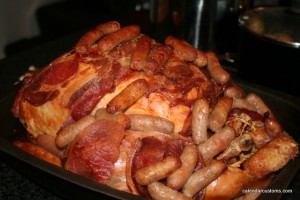
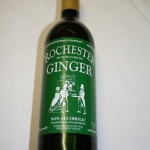
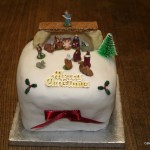
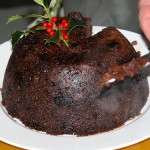

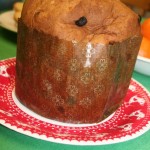
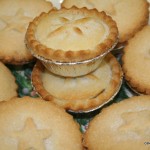
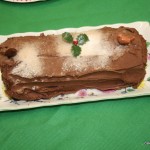
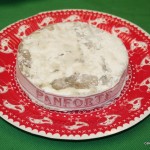
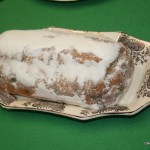
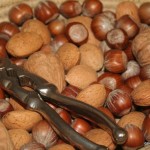
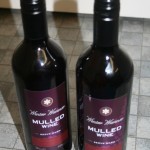
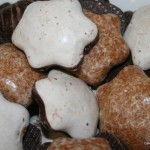
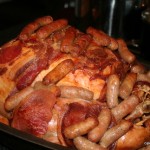
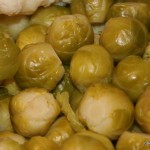
Well written, easily understood and prompts the taste buds effectively. Reading it was a welcome indulgence and an appropriate hors d’oeuvre to the impending festive season. The photographs are superb. I look forward to many more welcome indulgences throughout the year as I follow the calendar.
Soyer’s Christmas Feast
In 1852 celebrated chef Alexis Soyer organised a Christmas festival in Ham Yard, Windmill Street, London. 22,000 of the ‘poorest of the poor’ were fed with the following:
Roast and baked meat – 9000lb
Beef Pies – 178
Hare Pies – 50
Rabbit Pies – 60
Pork and Mutton Pies – 50
Roast Geese – 20
Whole Ox – 1
Potatoes – 3,300lb
Porter – 5000 pints
Plum pudding – 5000lb
Cakes – 50
Half-quartern loaves – 6000
Biscuits – 1 cask
Spanish nuts – 1 bushel
Chestnuts – 18 bushel
Oranges – 6 boxes
Tea – 6000oz
Coffee – 9000oz
Sugar – 2500lb
I dont suppose this counts as a custom but the tradition of cooking more food than can possibly be eaten seems to have been part of every Christmas meal I’ve been to.
(and I pinched the info from Schott’s Food & Drink Miscellany – full of useless info)
Info such as
Rosemary & Christmas
Rosemary was a popular Christmas decoration in the 19th century. St Thomas More said of it, “Tis the herb sacred to remembrance and therefore to friendship”. The chiorboys of Ripon carried it on Christmas morning as a sign of redemption. A number of legends link rosemary with Christmas: it is said that the herb’s purple hue derives from the robes of the Virgin Mary; that its aroma comes from the swaddling clothes of Christ (I’m not sure some of these are factually accurate); that the plant will never grow taller than Christ; and that if a rosemary bush lives longer than Christ’s 33 years, it will branch outwards not upwards. Because of these associations with Mary, it is said that rosemary grows best “where the mistress is master”.
That’s the problem with a lot of traditions and folk lore – totally bonkers….
More Swan anybody?
The Feast book of St John’s college Cambridge records Swans as being eaten at Christmas (1879 – 1894). In such dishes as Swan’s Giblet Soup. Nowadays the Crown’s rights over swans is enshrined in the wild creatures and forest laws act 1971 and the consumption of swans is prohibited by the wildlife and countryside act 1981.
However..
The following is a C15th recipe for preparing Roast Swan:
Kutte (cut) a swan in the rove (roof) of the mouthe towards the brayne enlonge, and lete him blede, and kepe the blode for chawdewyn (entrails) or else knytte a knot on his nek and so late his nekke breke; then skald him. Draw him and roast him even as thou doest goce (geese) in all poyntes, and serve him forth with chawdewyn.
Thanks for the contributions Paul! I’ve been preoccupied with starting to make my map for the site today, so sorry I’ve taken a while to reply!
Av
No problem – I was going to put in the different charms in a Christmas Pudding but thought that was your line of expertise.
Christmas Fruit cake with Wensleydale cheese – I was castigated for this as a student but I still stay true to my Yorkshire roots 🙂